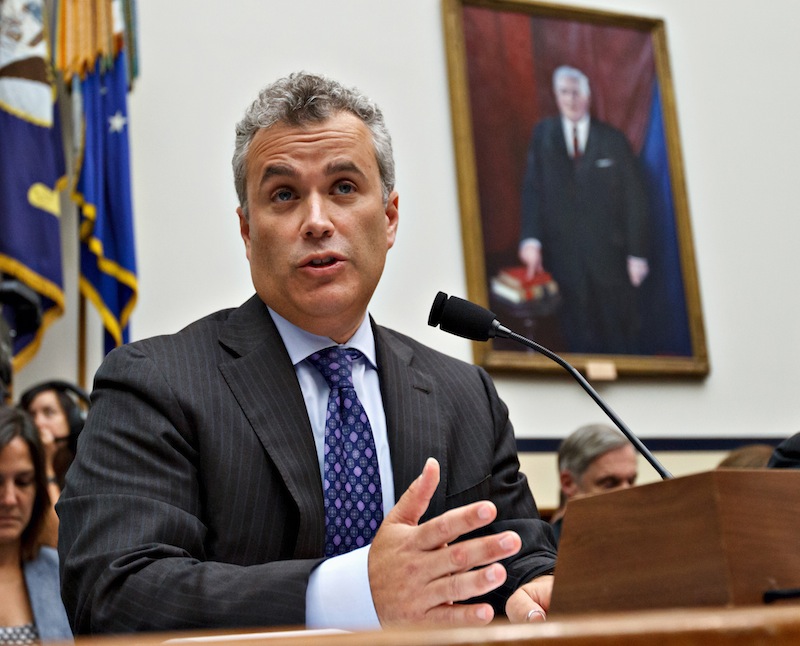WASHINGTON — Obamacare’s hobbled health-insurance exchange will be fixed by December, according to the management consultant asked to salvage the website, in the first timeline provided for correcting the flaws.
Jeffrey Zients, in his initial public comments since President Barack Obama assigned him the job this week, said Friday the site will be working “smoothly” by then. The project’s management has been reorganized, with UnitedHealth Group Inc.’s Quality Software Services unit taking over as lead contractor.
Since opening for business this month, the federal exchange serving 36 states has been plagued by delays, error messages and hang-ups that have prevented many customers from completing their enrollment. Ten Democratic senators led by Jeanne Shaheen of New Hampshire called on the Obama administration to extend the health law’s open-enrollment period beyond March 31.
“With the new general contractor in place and the focus that we have and what we have seen over the last couple of days, we are confident that each week the site will get better,” Zients told reporters on a conference call. “It’ll take a lot of work and there are a lot of problems that need to be addressed, but let me be clear: healthcare.gov is fixable.”
Sens. Mark Pryor of Arkansas, Mary Landrieu of Louisiana and Dianne Feinstein of California were also among those who signed the letter.
“As long as these substantial technology glitches persist, we are losing valuable time to educate and enroll people in insurance plans,” the senators wrote.
Healthcare.gov was intended as the main portal for millions of uninsured people in 36 of the 50 U.S. states to gain coverage from the Patient Protection and Affordable Care Act of 2010. The remaining 14 states built and are running their own sites independent of the federal government.
The number of people using the federal website exceeded the government’s expectations, Health and Human Services Secretary Kathleen Sebelius said at a news conference Friday in Austin, Texas.
“I don’t think anyone knew that the volume would cause the problems it did,” she said. “I didn’t realize it wouldn’t be operating optimally before the launch.”
The U.S. government did final tests of the website just days before it went public, while similar projects are tested for months, the main contractors told a House panel yesterday.
The site previously had no lead contractor. It was built largely by a unit of Montreal-based CGI Group Inc. The UnitedHealth unit, QSSI, built a service called the “data services hub” that collects information about customers from other federal agencies, including the Internal Revenue Service and Social Security Administration, and feeds it to both the federal website and sites run by states.
“The data hub, we believe, functions relatively smoothly,” Zients said.
QSSI and Oracle Corp. were also responsible for an identity management function used when customers create accounts on the site, according to people familiar with the project. Account creation was an early problem with the site; Zients said that 90 percent of customers can successfully complete that step now.
In its expanded role, QSSI is “overseeing the entire operation, making sure if one particular issue needs to be addressed, it gets prioritized and addressed right away,” Julie Bataille, a spokeswoman for the Centers for Medicare and Medicaid Services, said on the conference call.
“Working with CMS, QSSI will help monitor, assess, prioritize and manage the technical operations of healthcare.gov to enhance the consumer experience,” the company said in a statement sent by e-mail today.
It wasn’t clear whether the government officials previously in charge, including Henry Chao, the deputy chief information officer at CMS, would remain as managers.
CMS had been acting as its own “system integrator,” coordinating the work of 55 contractors and supervising testing before the site went live Oct. 1, Bataille said Oct. 24. That decision has been blamed for many of the site’s problems. Bataille didn’t directly answer a question today about whether QSSI would be the system integrator, instead saying the company’s role is “akin to a general contractor.”
Zients, 46, now a health-care entrepreneur, was named in September to replace Gene Sperling as director of the National Economic Council starting in January, after serving the government in the past as acting director of the Office of Management and Budget. He agreed this week to take a detour to his new job by helping advise the HHS on how to fix its website.
On the back end, health insurers have complained that information they receive from the government about their new customers is inaccurate or garbled. Zients said that problem “is at the top of the punch list” of issues with the site “and it’ll get punched out as fast as can be done.”
Despite the problems, about 700,000 people had completed insurance applications since the beginning of the month, the government said yesterday. The figure includes health insurance exchanges in 14 states that are running their own websites and report fewer problems. About half of the applications have come from states using the federal site, Bataille said.
Customers in states served by the federal exchange can apply by phone, where 17 government-run call centers have wait times measured in seconds, according to the government. They can also apply on paper using in-person assistance at community organizations and health clinics.
Send questions/comments to the editors.


